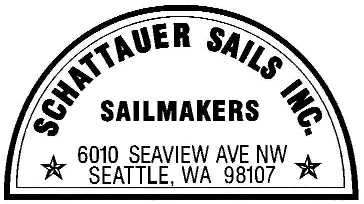
"Blending proven handwork and traditional sailmaking
methods with modern techniques of sail design and
construction to ensure good performance and lasting
durability."
|
|
|
|
|
|
|
|
|
|
| About Roller Furling Sails |
Our offshore, ultimate offshore sails and roller furling sails offer all of the same construction details; in other words, they are one and the same. Offshore roller furling sails are constructed with ease of use and durability in mind. They will feature premium Dacron fabric, double, triple or quadruple stitching, leech end seam reinforcements and the heaviest luff tape that will work with your furling system. A leech line and foot line are standard and if necessary a high cut headsail will feature an optional overhead leech line, which goes up the leech and down the luff for adjustment at the tack. This way, you will not be tempted adjust the leech line tension with a boat hook and fall over the side in the process. We will install long head and tack patches that extend into the sail so that as you roll the sail up to reef, there will be reinforcing at the "new" head and tack to take the loads. You do not want to roll up the sail past the corner patches since then you are asking the sail to hold up in heavier winds, relying on only the one layer of sail to take the load. Roller sails are optimized for protection from UV exposure since the sun acts on the sail whether it is being used or furled up at the dock. The head and tack ends will feature either leather protected webbing straps or webbed-on external stainless rings with leather caps. Our UV covers are installed so that the leech and foot sections are each in one piece whenever possible. The covers also wrap around the leech and foot hems to totally protect them from UV. We stitch the cover down with heavy thread and add "anti-inflate" stitching through the seams of the sail, not the body of the sail. That way, upon re-stitching the cover down the road, you will not perforate the single layer of sail fabric and, with the UV covers being installed in "one piece", there are not as many seams to re-stitch. Since the halyard acts only on the luff of the sail, there comes a point when the luff of the sail (head and tack) cannot help but creep together because there is nothing |
there to pull them apart. That is why foam or rope luff pads are optionally installed. The luff pads' purpose is to take The option of a Sunbrella UV Cover vs. a White
Dacron UV Cover comes down to weight, color and longevity. Sunbrella
weighs 9.25 oz./yd versus an excellent, UV Dacron coated on both sides
weighs 4.5 oz./yd. If
a sail is under 6 oz or so, it is highly recommended to go with UV
Dacron because there will be less weight on the unsupported leech to
fly better in lighter winds. However, UV Dacron will probably not last
as long as Sunbrella and it is available only in white. Once
the sail weight goes above 7.5 oz. or so, the weight difference of
either UV material is almost not noticeable. A
rough rule of thumb for life span of UV Dacron will be 6-8 years
and Sunbrella 8-12 years. Certainly there are exceptions to make
them last longer or shorter.
Finally, let's say you have been out sailing and the wind has been strong and you have increased the luff tension to keep the draft in the right location. Remember to unload the luff tension when you are back at the dock so that the sail does not remain tensioned at rest. This will help keep the optimum sail shape for a longer period of time.
|